Multiscale Remote Sensing Data Integration for Gully Erosion Monitoring in Southern Brazil: Case Study
Abstract
1. Introduction
2. Materials and Methods
2.1. Study Area
2.2. Data Acquisition and Pre-Processing
2.2.1. Field Data
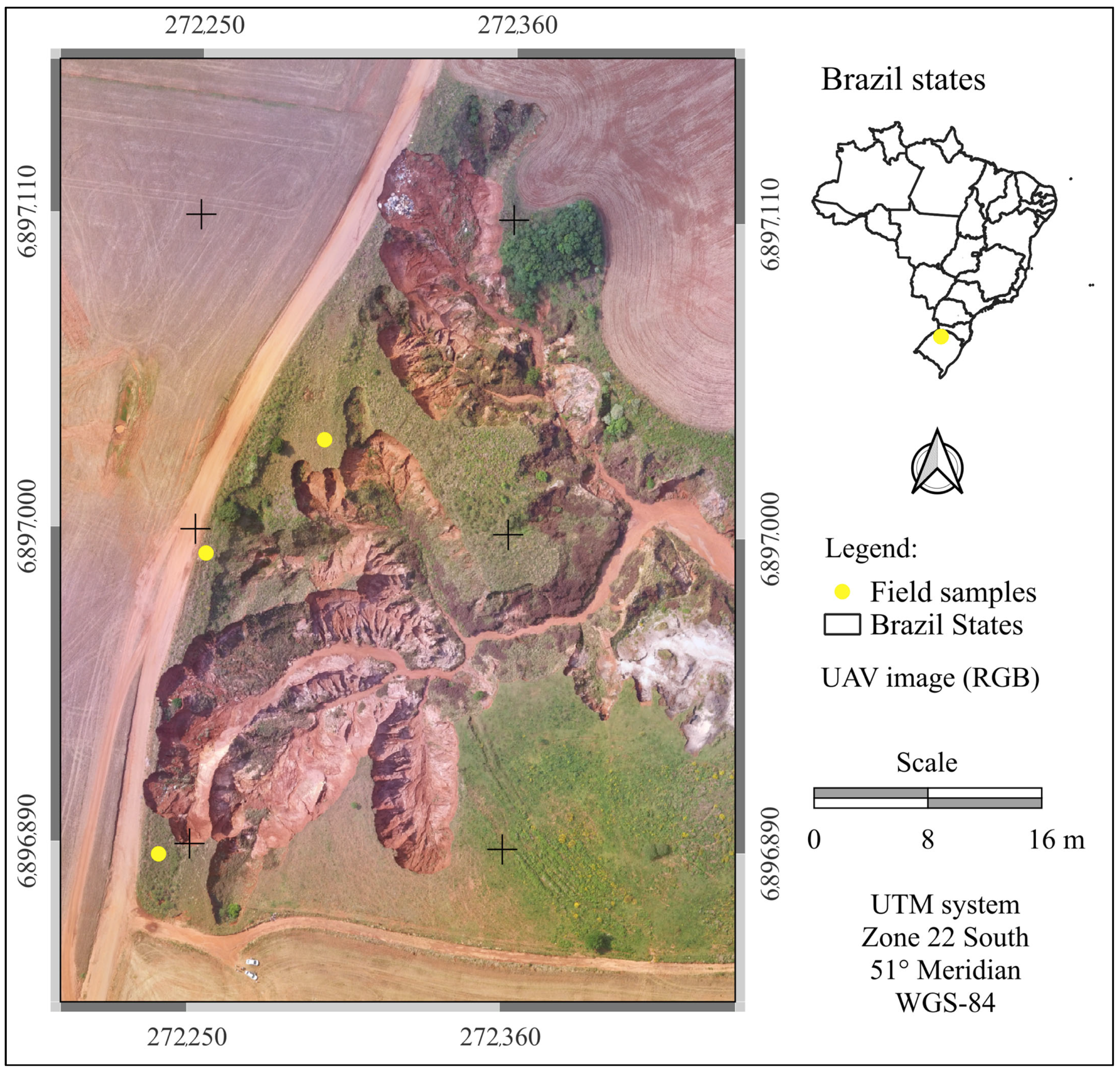
2.2.2. UAV Data
2.2.3. Conventional Aerial Data
2.2.4. Satellite Data—Google Earth Pro (GEP)
2.2.5. Ancillary Data
2.3. Data Analysis Procedures
3. Results
3.1. Gully Planimetric Area from Multiple Remote Sensing Data
3.2. Volumetry and Advanced Lines of Gully Erosion Processes
4. Discussion
4.1. Planimetric and Volumetric Variables and Gully Evolution
4.2. Geomorphological Analysis of the Gully
4.3. General Constraints of the Study
5. Conclusions
Supplementary Materials
Author Contributions
Funding
Data Availability Statement
Acknowledgments
Conflicts of Interest
Abbreviations
| UAV | Unmanned Aerial Vehicle |
| GEP | Google Earth Pro |
| DSG | Brazilian Directory of Geographic Service |
| EMBRAPA | Brazilian Agricultural Research Corporation |
| RGB | Red–Green–Blue |
| GCP | Ground Control Points |
| DEM | Digital Elevation Model |
| DTM | Digital Terrain Model |
References
- Flexor, G.; Kato, K.Y.; Leite, S.P. Agri-Food Globalization and Food Security in Brazil: Recent Trends and Contradictions. J. Peasant. Stud. 2024, 51, 1022–1045. [Google Scholar] [CrossRef]
- Avni, Y. Gully Incision as a Key Factor in Desertification in an Arid Environment, the Negev Highlands, Israel. Catena 2005, 63, 185–220. [Google Scholar] [CrossRef]
- Vrieling, A. Satellite Remote Sensing for Water Erosion Assessment: A Review. Catena 2006, 65, 2–18. [Google Scholar] [CrossRef]
- Vrieling, A. Mapping Erosion from Space; Erosion and Soil & Water Conservation Group, Department of Environmental Sciences, Wageningen University and Research Centre: Wageningen, The Netherlands, 2007; pp. 926–9495. ISBN 9789085045878. [Google Scholar]
- Simões, M.; Ferraz, R.P.D.; Lumbreras, J.F.; Coelho, M.R.; Baca, J.M.; de Freitas, P.L.; Lima, E.d.P.; Kuchler, P.C.; Almeida, M.B.F. De Mapa de Vulnerabilidade dos Solos à Erosão Hídrica do Brasil—2019 (Primeira Aproximação) [CNPS]. Available online: https://geoinfo.dados.embrapa.br/catalogue/#/dataset/2997 (accessed on 16 January 2025).
- Lal, R. Soil Degradation as a Reason for Inadequate Human Nutrition. Food Secur. 2009, 1, 45–57. [Google Scholar] [CrossRef]
- Haruna, S.I.; Nkongolo, N.V. Cover Crop Management Effects on Soil Physical and Biological Properties. Procedia Environ. Sci. 2015, 29, 13–14. [Google Scholar] [CrossRef]
- Krynke, M. Management Optimizing the Costs and Duration Time of the Process in the Production System. Prod. Eng. Arch. 2021, 27, 163–170. [Google Scholar] [CrossRef]
- Dummer, J.; Verdum, R. Controle Estrutural Nos Processos Erosivos Hídricos e Na Arenização, Bacia Hidrográfica Do Arroio Miracatu—Rio Grande Do Sul. Rev. Bras. De Geomorfol. 2023, 24, 1–27. [Google Scholar] [CrossRef]
- Milton, L.E. A Review of Gully Erosion and Its Control; Soil Conservation Authority: Kew, Australia, 1971. [Google Scholar]
- Natural Resources and Water Government—NRW Gully Erosion Assessment and Control Guide. Available online: https://www.lls.nsw.gov.au/help-and-advice/natural-resource-management/waterways/gully-erosion-assessment-and-control-guide (accessed on 16 January 2025).
- Peter, K.D.; d’Oleire-Oltmanns, S.; Ries, J.B.; Marzolff, I.; Hssaine, A.A. Soil Erosion in Gully Catchments Affected by Land-Levelling Measures in the Souss Basin, Morocco, Analysed by Rainfall Simulation and UAV Remote Sensing Data. Catena 2014, 113, 24–40. [Google Scholar] [CrossRef]
- Arabameri, A.; Asadi Nalivan, O.; Saha, S.; Roy, J.; Pradhan, B.; Tiefenbacher, J.P.; Thi Ngo, P.T. Novel Ensemble Approaches of Machine Learning Techniques in Modeling the Gully Erosion Susceptibility. Remote Sens. 2020, 12, 1890. [Google Scholar] [CrossRef]
- Hessel, R.; van Asch, T. Modelling Gully Erosion for a Small Catchment on the Chinese Loess Plateau. Catena 2003, 54, 131–146. [Google Scholar] [CrossRef]
- Stroosnijder, L. Measurement of Erosion: Is It Possible? Catena 2005, 64, 162–173. [Google Scholar] [CrossRef]
- Poesen, J.; Nachtergaele, J.; Verstraeten, G.; Valentin, C. Gully Erosion and Environmental Change: Importance and Research Needs. Catena 2003, 50, 91–133. [Google Scholar] [CrossRef]
- Bouramtane, T.; Hilal, H.; Rezende-Filho, A.T.; Bouramtane, K.; Barbiero, L.; Abraham, S.; Valles, V.; Kacimi, I.; Sanhaji, H.; Torres-Rondon, L.; et al. Mapping Gully Erosion Variability and Susceptibility Using Remote Sensing, Multivariate Statistical Analysis, and Machine Learning in South Mato Grosso, Brazil. Geosciences 2022, 12, 235. [Google Scholar] [CrossRef]
- Rademann, L.K.; Trentin, R.; Robaina, L.E.D.S.; Breunig, F.M. Avaliação Da Dinâmica De Bancos De Areia Com Imagens De Alta Resolução No Rio Areal Do Limeira, Sul Do Brasil. RAEGA-O Espaço GeográFico Álise 2023, 57, 3. [Google Scholar] [CrossRef]
- Wang, B.; Zhang, Z.; Wang, X.; Zhao, X.; Yi, L.; Hu, S. The Suitability of Remote Sensing Images at Different Resolutions for Mapping of Gullies in the Black Soil Region, Northeast China. Remote Sens. 2021, 13, 2367. [Google Scholar] [CrossRef]
- Zhang, C.; Wang, C.; Long, Y.; Pang, G.; Shen, H.; Wang, L.; Yang, Q. Comparative Analysis of Gully Morphology Extraction Suitability Using Unmanned Aerial Vehicle and Google Earth Imagery. Remote Sens. 2023, 15, 4302. [Google Scholar] [CrossRef]
- Zgłobicki, W.; Poesen, J.; Cohen, M.; Del Monte, M.; García-Ruiz, J.M.; Ionita, I.; Niacsu, L.; Machová, Z.; Martín-Duque, J.F.; Nadal-Romero, E.; et al. The Potential of Permanent Gullies in Europe as Geomorphosites. Geoheritage 2019, 11, 217–239. [Google Scholar] [CrossRef]
- Toro, F.G.; Tsourdos, A. UAV or Drones for Remote Sensing Applications; MDPI-Multidisciplinary Digital Publishing Institute: Basel, Switzerland, 2018; ISBN 9783038970910. [Google Scholar]
- Prudkin, G.; Breunig, F.M. DRONES E CIÊNCIA: Teoria e Aplicações Metodológicas, 1st ed.; Prudkin, G., Breunig, F.M., Eds.; FACOS UFSM: Santa Maria, RS, Brazil, 2019; ISBN 9788583840770. [Google Scholar]
- Radoglou-Grammatikis, P.; Sarigiannidis, P.; Lagkas, T.; Moscholios, I. A Compilation of UAV Applications for Precision Agriculture. Comput. Netw. 2020, 172, 107148. [Google Scholar] [CrossRef]
- Pajares, G. Overview and Current Status of Remote Sensing Applications Based on Unmanned Aerial Vehicles (UAVs). Photogramm. Eng. Remote Sens. 2015, 81, 281–330. [Google Scholar] [CrossRef]
- Verdum, R. Approche Géographique Des “Déserts” Dans Les Communes de São Francisco de Assis et Manuel Viana, Etat Du Rio Grande Do Sul, Brésil. Ph.D. Thesis, Université de Toulouse Le Mirail, Toulouse, France, 1997. [Google Scholar]
- Kasecker, T.P.; Ramos-Neto, M.B.; da Silva, J.M.C.; Scarano, F.R. Ecosystem-Based Adaptation to Climate Change: Defining Hotspot Municipalities for Policy Design and Implementation in Brazil. Mitig. Adapt. Strateg. Glob. Change 2018, 23, 981–993. [Google Scholar] [CrossRef]
- Hall, O. Remote Sensing in Social Science Research. Open Remote Sens. J. 2010, 3, 1–16. [Google Scholar] [CrossRef]
- Guerra, A.J.T.; Jorge, M.D.C.O. Processos Erosivos e Recuperação de Áreas Degradadas; Oficina de Textos: São Paulo, Brazil, 2013; ISBN 9788579750793. [Google Scholar]
- Guerra, A.J.T.; Fullen, M.A.; Bezerra, J.F.R.; Jorge, M.D.C.O. Gully Erosion and Land Degradation in Brazil: A Case Study from São Luís Municipality, Maranhão State. In Ravine Lands: Greening for Livelihood and Environmental Security; Springer: Singapore, 2018; pp. 195–216. [Google Scholar]
- Castillo, C.; Gómez, J.A. A Century of Gully Erosion Research: Urgency, Complexity and Study Approaches. Earth Sci. Rev. 2016, 160, 300–319. [Google Scholar] [CrossRef]
- Robaina, L.E.d.S.; De Paula, P.M.; Trentin, R. Soil Degradation and Developments of the Sands in Ibicui Basin—RS—Brazil. Soc. Nat. 2005, 1, 215–223. [Google Scholar] [CrossRef]
- Suertegaray, D.M.A.; Oliveira, M.G. Sandization, Sand Spots and Land Use Planning (Arenização, Areais e Políticas de Ordenamento Territorial). Cad. Geogr. 2018, 38, 69–76. [Google Scholar]
- Trindade, J.P.P.; de Quadros, F.L.F.; Pillar, V.D. Vegetação Campestre de Areais Do Sudoeste Do Rio Grande Do Sul Sob Pastejo e Com Exclusão Do Pastejo. Pesqui. Agropecu. Bras. 2008, 43, 771–779. [Google Scholar] [CrossRef]
- Cabral, T.L.; Nummer, A.V.; Bateira, C.V. Morphometric Indicators as Support for the Classification of Gullies in Hydrographic Sub-Basins in the Cacequi Municipality, RS (in Portuguese—Indicadores Morfométricos Como Suporte Para a Classificação de Voçorocas Em Sub-Bacias Hidrográficas No Município de Cacequi, RS. Rev. Bras. Geomorfol. 2020, 21. [Google Scholar] [CrossRef]
- Rademann, L.K.; Trentin, R.; Robaina, L.E. Characterization and Analysis of Gully Erosion in Southern Brazil with the Assistance of Unmanned Aerial Vehicle. Mercator 2022, 21, e21022. [Google Scholar] [CrossRef]
- Gaberti, M.M.; Robaina, L.E.d.S.; Trentin, R. Relação Entre Condicionantes Ambientais e Ocorrência de Voçorocas No Município de Capão Do Cipó/RS. Geografia 2023, 33, 189–207. [Google Scholar] [CrossRef]
- Coulon, F.K.; Gamermann, N.; Formoso, M.L.L. Considerações Sobre a Gênese Da Formação Tupanciretã. Pesqui. GeociêNcias 1973, 2, 79. [Google Scholar] [CrossRef]
- Sangiovo, S. Degradação Ambiental Por Processos Erosivos No Município de Palmeira Das Missões—RS; UFSM: Frederico Westphalen, Brazil, 2015. [Google Scholar]
- Alvares, C.A.; Stape, J.L.; Sentelhas, P.C.; De Moraes Gonçalves, J.L.; Sparovek, G. Köppen’s Climate Classification Map for Brazil. Meteorol. Z. 2013, 22, 711–728. [Google Scholar] [CrossRef]
- Beck, H.E.; McVicar, T.R.; Vergopolan, N.; Berg, A.; Lutsko, N.J.; Dufour, A.; Zeng, Z.; Jiang, X.; van Dijk, A.I.J.M.; Miralles, D.G. High-Resolution (1 Km) Köppen-Geiger Maps for 1901–2099 Based on Constrained CMIP6 Projections. Sci. Data 2023, 10, 724. [Google Scholar] [CrossRef] [PubMed]
- EMBRAPA (Empresa Brasileira de Pesquisa Agropecuária) Solos. Sistema Brasileiro de Classificação de Solos; EMBRAPA (Empresa Brasileira de Pesquisa Agropecuária) Solos: Rio de Janeiro, Brazilm, 2013; Volume 1, p. 353. ISBN 978-85-7035-198-2. [Google Scholar]
- Instituto Brasileiro de Geografia e Estatística (IBGE). Land Use and Cover in Brazil; Instituto Brasileiro de Geografia e Estatística (IBGE): Rio de Janeiro, Brazil, 2020. [Google Scholar]
- Secretaria de Planejamento, Ordenamento e Gestão do Rio Grande do Sul. Produção Agropecuária e Estrutura Fundiária Atlas Socioeconômico Do Rio Grande Do Sul; Secretaria de Planejamento, Ordenamento e Gestão do Rio Grande do Sul: Porto Alegre, RS, Brazil, 2019. [Google Scholar]
- Ruppel, K.M.V.; Dani, N.; Amoretti Lisboa, N. Evolução Morfotectônica e Megageomorfológica Das Formações Pós Gondwânicas Santa Tecla e Tupanciretã No Rio Grande Do Sul. Rev. Bras. Geomorfol. 2023, 24. [Google Scholar] [CrossRef]
- Menegotto, E.; Sartori, P.L.P.; Maciel Filho, C.L. Nova Sequência Sedimentar Sobre a Serra Geral No Rio Grande Do Sul. Bol. Inst. Solos Cult. 1968, 1, 1–19. [Google Scholar]
- Instituto Brasileiro de Geografia e Estatística (IBGE). Manual Técnico Da Vegetação Brasileira, 2nd ed.; IBGE Instituto Brasileiro de Geografia e Estatística: Rio de Janeiro, Brazil, 2012. [Google Scholar]
- Instituto Brasileiro de Geografia e Estatística—IBGE Base de Dados de Geociências 2025—Downloads. IBGE: Rio de Janeiro, Brazil. Available online: https://www.ibge.gov.br/geociencias/downloads-geociencias.html (accessed on 2 May 2025).
- DJI—Dà-Jiāng Innovations Matrice 100: The Quadcopter for Developers—DJI. Available online: https://www.dji.com/matrice100?site=brandsite&from=nav (accessed on 7 May 2018).
- DJI—Dà-Jiāng Innovations All Phantom Products- Intelligent Drones—DJI. Available online: https://www.dji.com/products/all-phantom?site=brandsite&from=landing_page (accessed on 7 May 2018).
- Teixeira, P.C.; Donagemma, G.K.; Fontana, A.; Teixeira, W.G. Manual de Métodos de Análise de Solo, 3rd ed.; Embrapa: Brasília, DF, Brazil, 2017; ISBN 978-85-7035-771-7. [Google Scholar]
- Agisoft, L. Рукoвoдствo Пoльзoвателя Agisoft Metashape; Agisoft: St. Petersburg, Russia, 2024; Available online: https://www.agisoft.com/ (accessed on 15 April 2025).
- Westoby, M.J.; Brasington, J.; Glasser, N.F.; Hambrey, M.J.; Reynolds, J.M. ‘Structure-from-Motion’ Photogrammetry: A Low-Cost, Effective Tool for Geoscience Applications. Geomorphology 2012, 179, 300–314. [Google Scholar] [CrossRef]
- Jonathan, L.; Carrivick, M.W.; Smith, D.J.Q. Structure from Motion in the Geosciences; Wiley-Blackwell: Singapore, 2016; ISBN 978-1-118-89584-9. [Google Scholar]
- QGIS.org, 2025. QGIS Geographic Information System v3.40. QGIS Association. Available online: http://www.qgis.org (accessed on 15 April 2025).
- Wang, X.W.; Wang, F. The Precision of Google Earth Map Analysis with the Coordinates of IGS Stations. Int. Arch. Photogramm. Remote Sens. Spat. Inf. Sci. 2020, XLII-3/W10, 1053–1056. [Google Scholar] [CrossRef]
- Vianna, L.F.d.N.; Perin, E.B.; Ricce, W.d.S.; Massignan, A.M.; Pandolfo, C. Bancos de Dados Meteorológicos: Análise Dos Metadados Das Estações Meteorológicas No Estado de Santa Catarina, Brasil. Rev. Bras. Meteorol. 2017, 32, 53–64. [Google Scholar] [CrossRef]
- Huffman, G.J.; Stocker, E.F.; Bolvin, D.T.; Nelkin, E.J.; Tan, J. GPM IMERG Final Precipitation L3 Half Hourly 0.1 Degree × 0.1 Degree V06 (GPM_3IMERGHH); Goddard Earth Sciences Data and Information Services Center (GES DISC): Greenbelt, MD, USA, 2019. [Google Scholar]
- Funk, C.; Peterson, P.; Landsfeld, M.; Pedreros, D.; Verdin, J.; Shukla, S.; Husak, G.; Rowland, J.; Harrison, L.; Hoell, A.; et al. The Climate Hazards Infrared Precipitation with Stations—A New Environmental Record for Monitoring Extremes. Sci. Data 2015, 2, 150066. [Google Scholar] [CrossRef]
- Borrelli, P.; Matthews, F.; Alewell, C.; Kaffas, K.; Poesen, J.; Saggau, P.; Prăvălie, R.; Vanmaercke, M.; Panagos, P. A Hybrid in Situ and On-Screen Survey to Monitor Gully Erosion across the European Union. Sci. Data 2025, 12, 755. [Google Scholar] [CrossRef]
- Reece, D.A.; Lory, J.A.; Haithcoat, T.L.; Gelder, B.K.; Cruse, R. Using Google Earth Imagery to Target Assessments of Ephemeral Gully Erosion. J. Asabe 2023, 66, 155–166. [Google Scholar] [CrossRef]
- Sidorchuk, A. Models of Gully Erosion by Water. Water 2021, 13, 3293. [Google Scholar] [CrossRef]
- Mawe, G.I.; Landu, E.L.; Imwangana, F.M.; Hubert, A.; Dille, A.; Bielders, C.L.; Poesen, J.; Dewitte, O.; Vanmaercke, M. What Controls the Expansion of Urban Gullies in Tropical Environments? Lessons Learned from Contrasting Cities in DR Congo. Catena 2024, 241, 108055. [Google Scholar] [CrossRef]
- Wang, J.; Zhang, Y.; Chen, C.; Li, K. Spatial Variation in Gully Expansion Rate in a Loess-Covered Tableland Region Based on Systematic Sampling and High-Resolution Image Interpretation. Catena 2024, 236, 107756. [Google Scholar] [CrossRef]
- Titti, G.; Napoli, G.N.; Conoscenti, C.; Lombardo, L. Cloud-Based Interactive Susceptibility Modeling of Gully Erosion in Google Earth Engine. Int. J. Appl. Earth Obs. Geoinf. 2022, 115, 103089. [Google Scholar] [CrossRef]
- Krein Rademann, L.; Trentin, R. Novas Geotecnologias Aplicadas Ao Estudo Geomorfológico: Exemplo de Morfometria Da Voçoroca Do Areal, Cacequi-RS. GeoTextos 2020, 16. [Google Scholar] [CrossRef]
- Ma, H.; Zhou, W.; Zhang, L. DEM Refinement by Low Vegetation Removal Based on the Combination of Full Waveform Data and Progressive TIN Densification. ISPRS J. Photogramm. Remote Sens. 2018, 146, 260–271. [Google Scholar] [CrossRef]
- Ding, J.; Li, Z.; Zhang, H.; Zhang, P.; Cao, X.; Feng, Y. Quantifying the Aboveground Biomass (AGB) of Gobi Desert Shrub Communities in Northwestern China Based on Unmanned Aerial Vehicle (UAV) RGB Images. Land 2022, 11, 543. [Google Scholar] [CrossRef]
- Fernandes, M.M.; José, M.B.; Vieira, M.V.A.; Nascimento, C.C.F.; Almeida, A.Q. Litter Stock in Different Areas in the Process of Ecological Restoration Intercropped with Eucalyptus in the Brazilian Atlantic Forest (Estoque de Serapilheira Em Diferentes Áreas Em Processo de Restauração Ecológica Consorciadas Com Eucalipto Na Mata Atlântica Brasileira). Rev. CiêNcias AgroveterináRias 2024, 23, 763–770. [Google Scholar] [CrossRef]
- Jugie, M.; Gob, F.; Virmoux, C.; Brunstein, D.; Tamisier, V.; Le Coeur, C.; Grancher, D. Characterizing and Quantifying the Discontinuous Bank Erosion of a Small Low Energy River Using Structure-from-Motion Photogrammetry and Erosion Pins. J. Hydrol. 2018, 563, 418–434. [Google Scholar] [CrossRef]
- Willett, S.D.; McCoy, S.W.; Perron, J.T.; Goren, L.; Chen, C.-Y. Dynamic Reorganization of River Basins. Science 2014, 343, 1248765. [Google Scholar] [CrossRef]
- Escobar Villanueva, J.R.; Iglesias Martínez, L.; Pérez Montiel, J.I. DEM Generation from Fixed-Wing UAV Imaging and LiDAR-Derived Ground Control Points for Flood Estimations. Sensors 2019, 19, 3205. [Google Scholar] [CrossRef]
- Meng, X.; Shang, N.; Zhang, X.; Li, C.; Zhao, K.; Qiu, X.; Weeks, E. Photogrammetric UAV Mapping of Terrain under Dense Coastal Vegetation: An Object-Oriented Classification Ensemble Algorithm for Classification and Terrain Correction. Remote Sens. 2017, 9, 1187. [Google Scholar] [CrossRef]

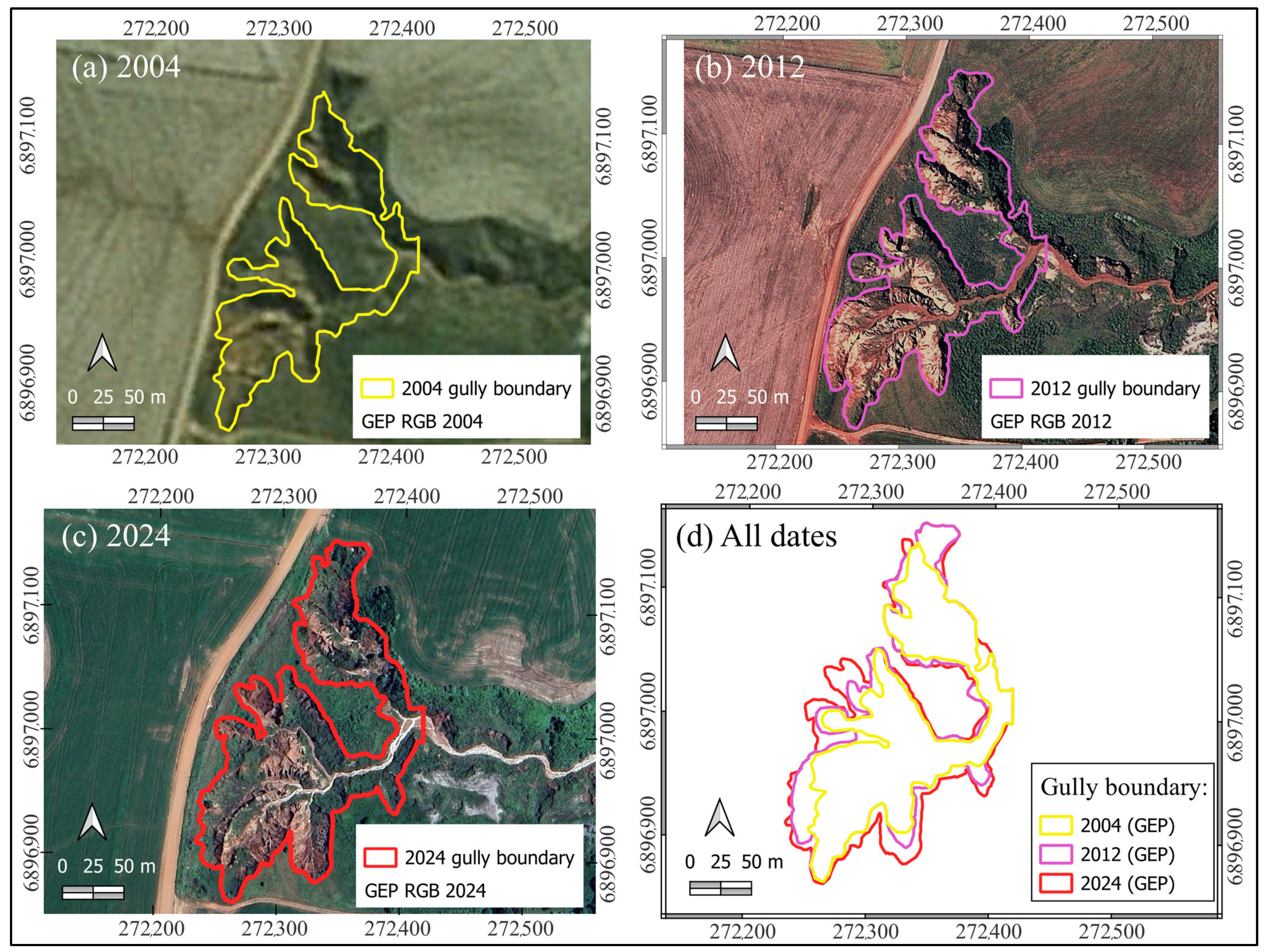
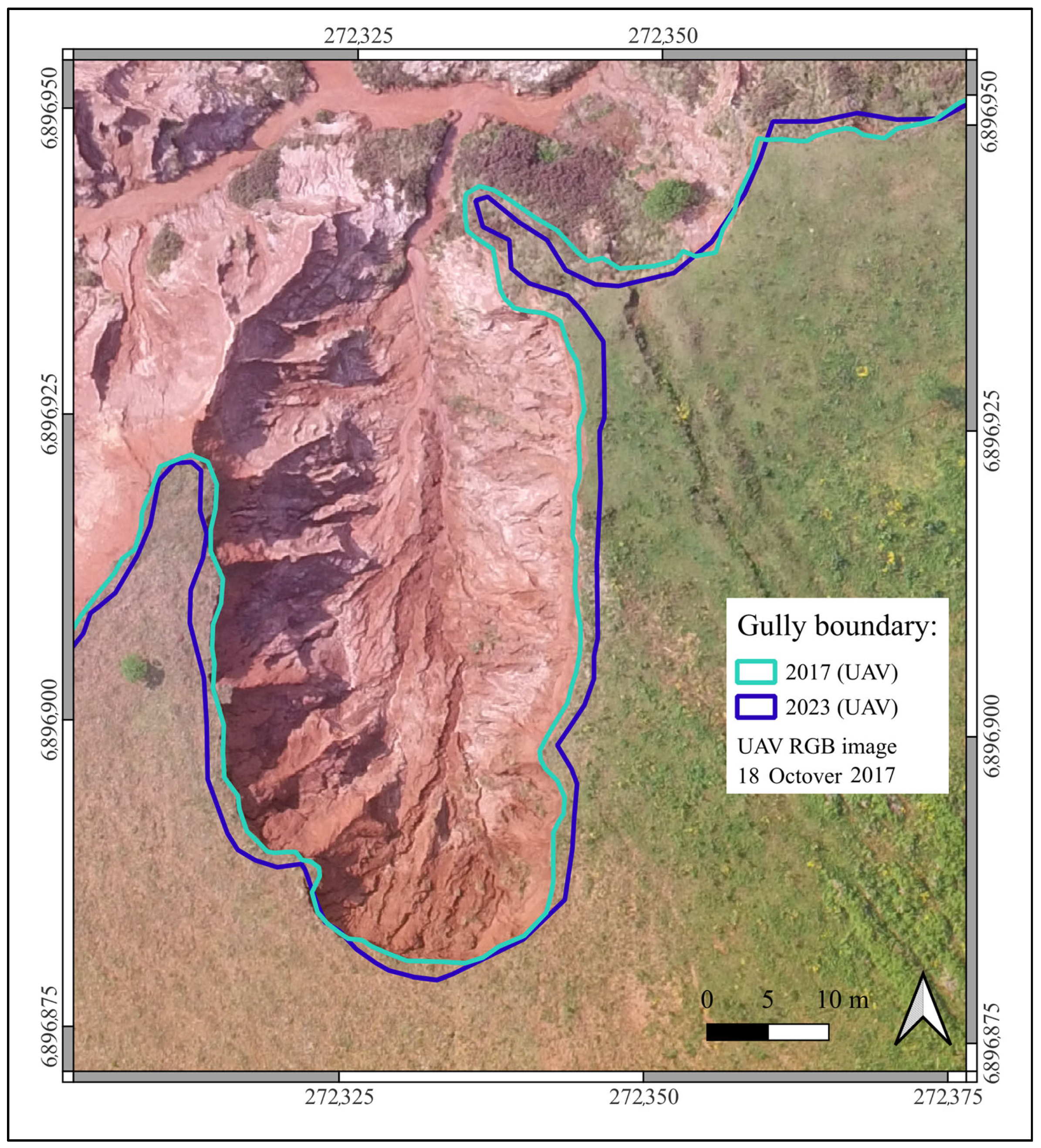

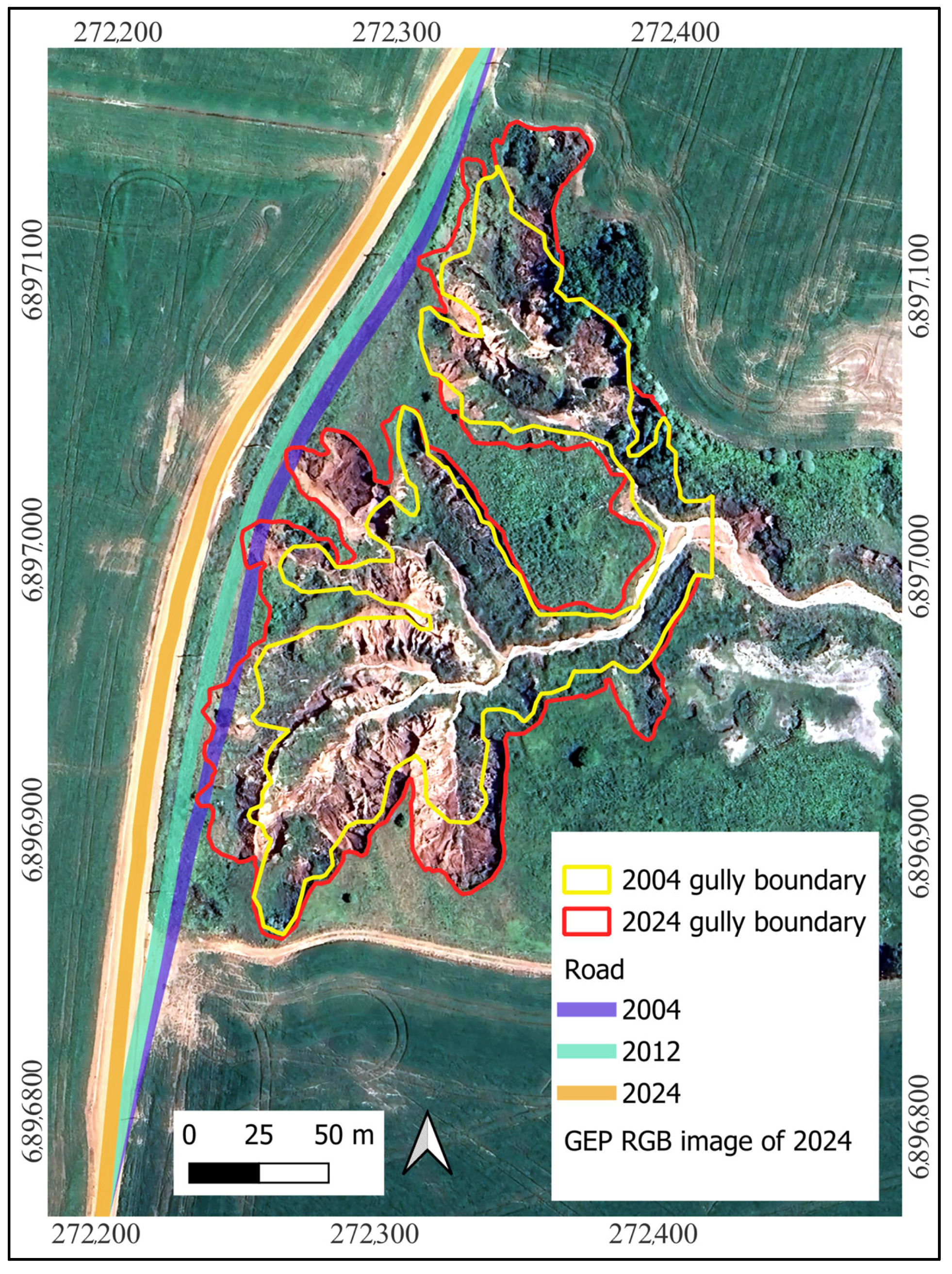


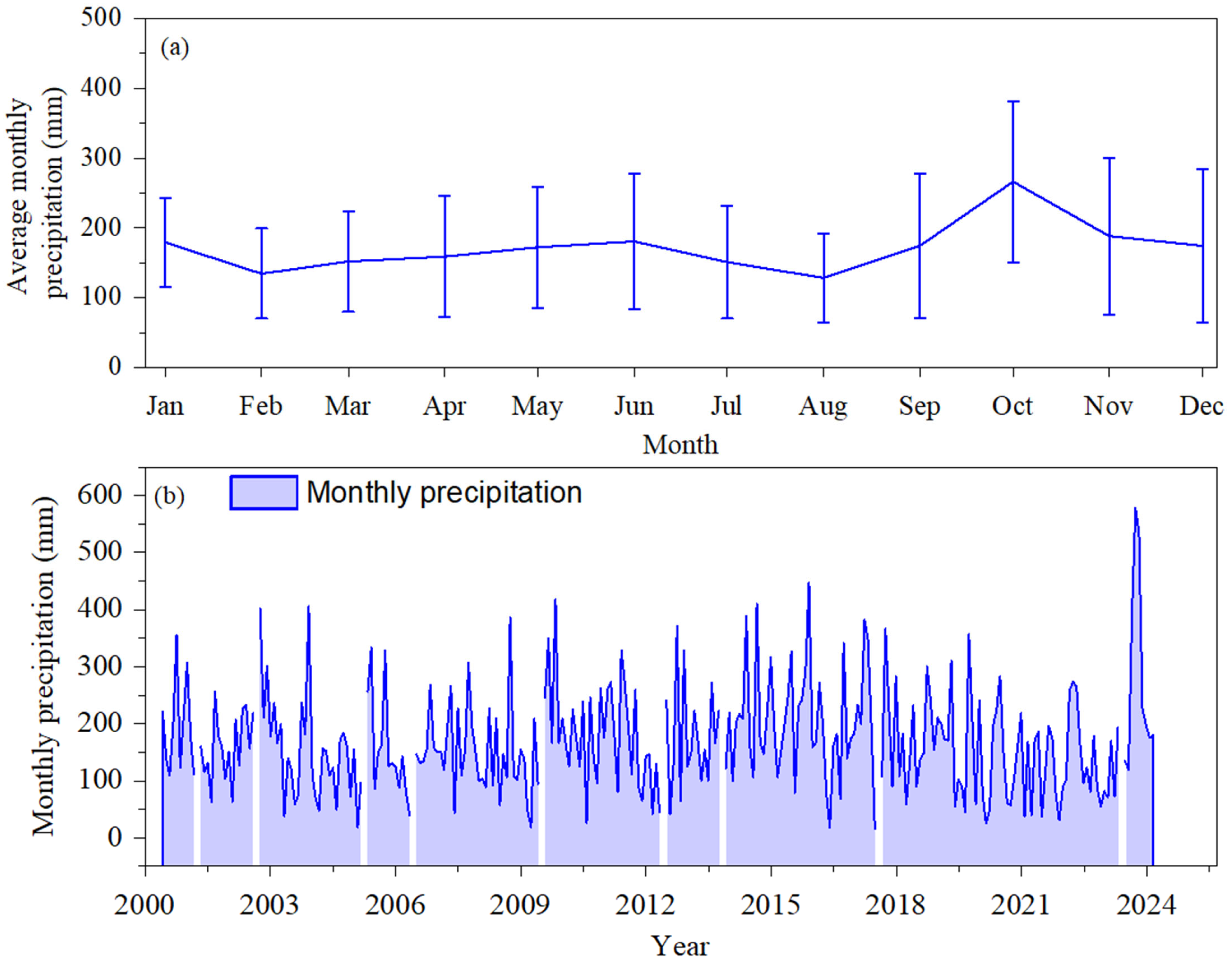

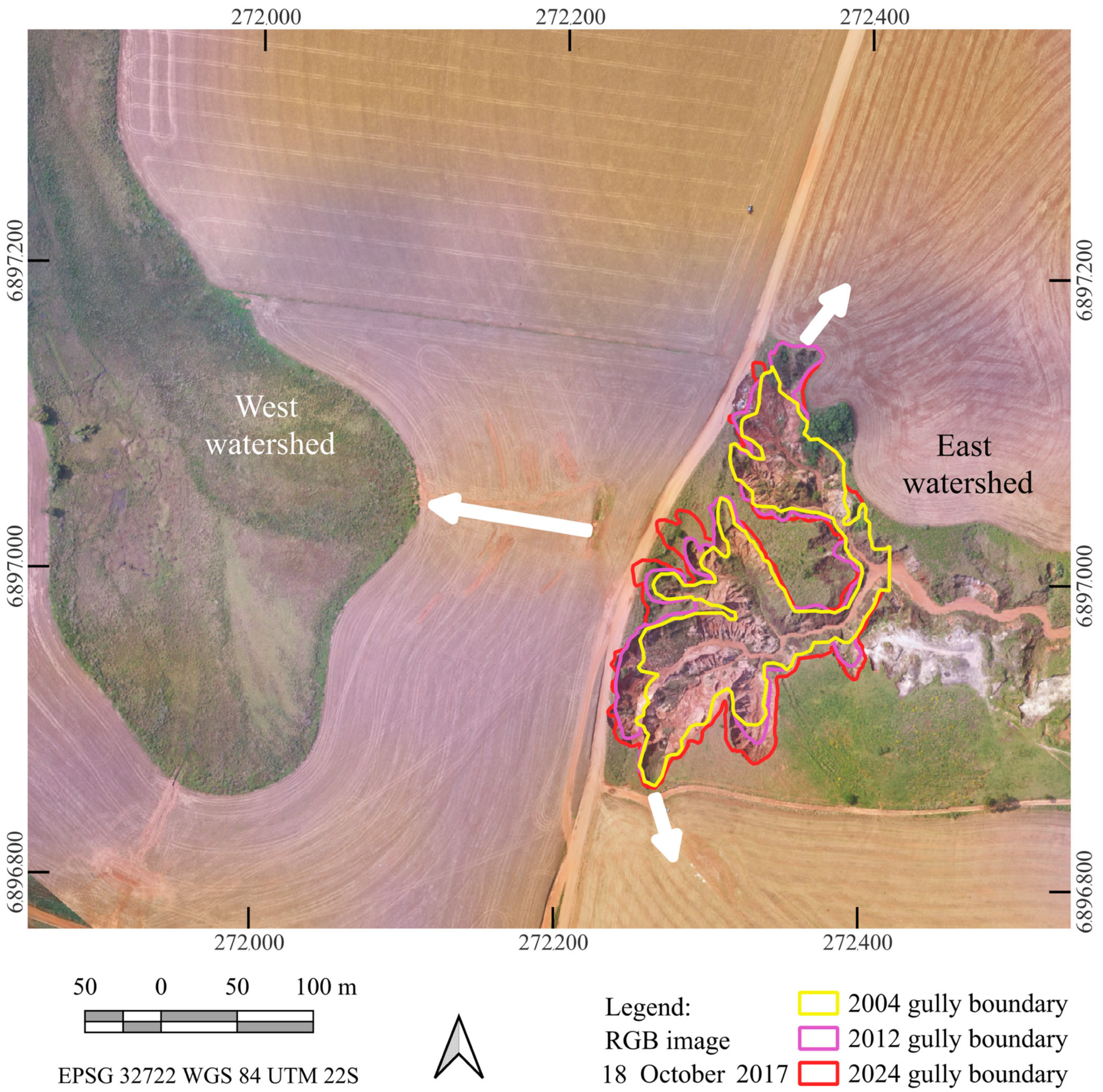
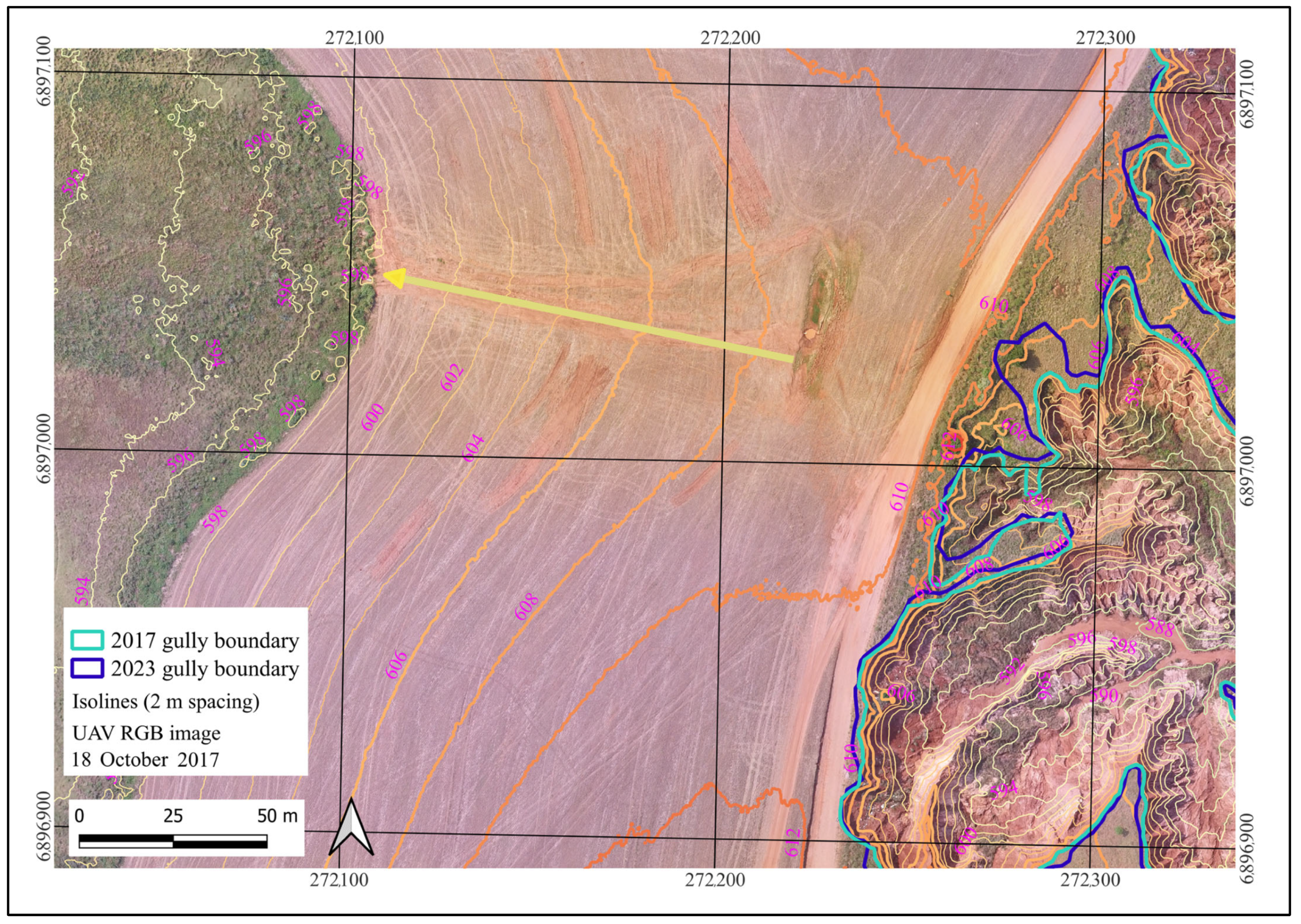

Disclaimer/Publisher’s Note: The statements, opinions and data contained in all publications are solely those of the individual author(s) and contributor(s) and not of MDPI and/or the editor(s). MDPI and/or the editor(s) disclaim responsibility for any injury to people or property resulting from any ideas, methods, instructions or products referred to in the content. |
© 2025 by the authors. Licensee MDPI, Basel, Switzerland. This article is an open access article distributed under the terms and conditions of the Creative Commons Attribution (CC BY) license (https://creativecommons.org/licenses/by/4.0/).
Share and Cite
Breunig, F.M.; Mancuso, M.A.; Coimbra, A.C.A.; Santos, L.J.C.; Hempe, T.C.; Frick, E.d.C.d.L.; Nascimento, E.R.d.; Sampaio, T.V.M.; Gaida, W.; Berra, E.F.; et al. Multiscale Remote Sensing Data Integration for Gully Erosion Monitoring in Southern Brazil: Case Study. AgriEngineering 2025, 7, 212. https://doi.org/10.3390/agriengineering7070212
Breunig FM, Mancuso MA, Coimbra ACA, Santos LJC, Hempe TC, Frick EdCdL, Nascimento ERd, Sampaio TVM, Gaida W, Berra EF, et al. Multiscale Remote Sensing Data Integration for Gully Erosion Monitoring in Southern Brazil: Case Study. AgriEngineering. 2025; 7(7):212. https://doi.org/10.3390/agriengineering7070212
Chicago/Turabian StyleBreunig, Fábio Marcelo, Malva Andrea Mancuso, Ana Clara Amalia Coimbra, Leonardo José Cordeiro Santos, Tais Cristina Hempe, Elaine de Cacia de Lima Frick, Edenilson Roberto do Nascimento, Tony Vinicius Moreira Sampaio, William Gaida, Elias Fernando Berra, and et al. 2025. "Multiscale Remote Sensing Data Integration for Gully Erosion Monitoring in Southern Brazil: Case Study" AgriEngineering 7, no. 7: 212. https://doi.org/10.3390/agriengineering7070212
APA StyleBreunig, F. M., Mancuso, M. A., Coimbra, A. C. A., Santos, L. J. C., Hempe, T. C., Frick, E. d. C. d. L., Nascimento, E. R. d., Sampaio, T. V. M., Gaida, W., Berra, E. F., Trentin, R., Othman, A. A., & Liesenberg, V. (2025). Multiscale Remote Sensing Data Integration for Gully Erosion Monitoring in Southern Brazil: Case Study. AgriEngineering, 7(7), 212. https://doi.org/10.3390/agriengineering7070212











